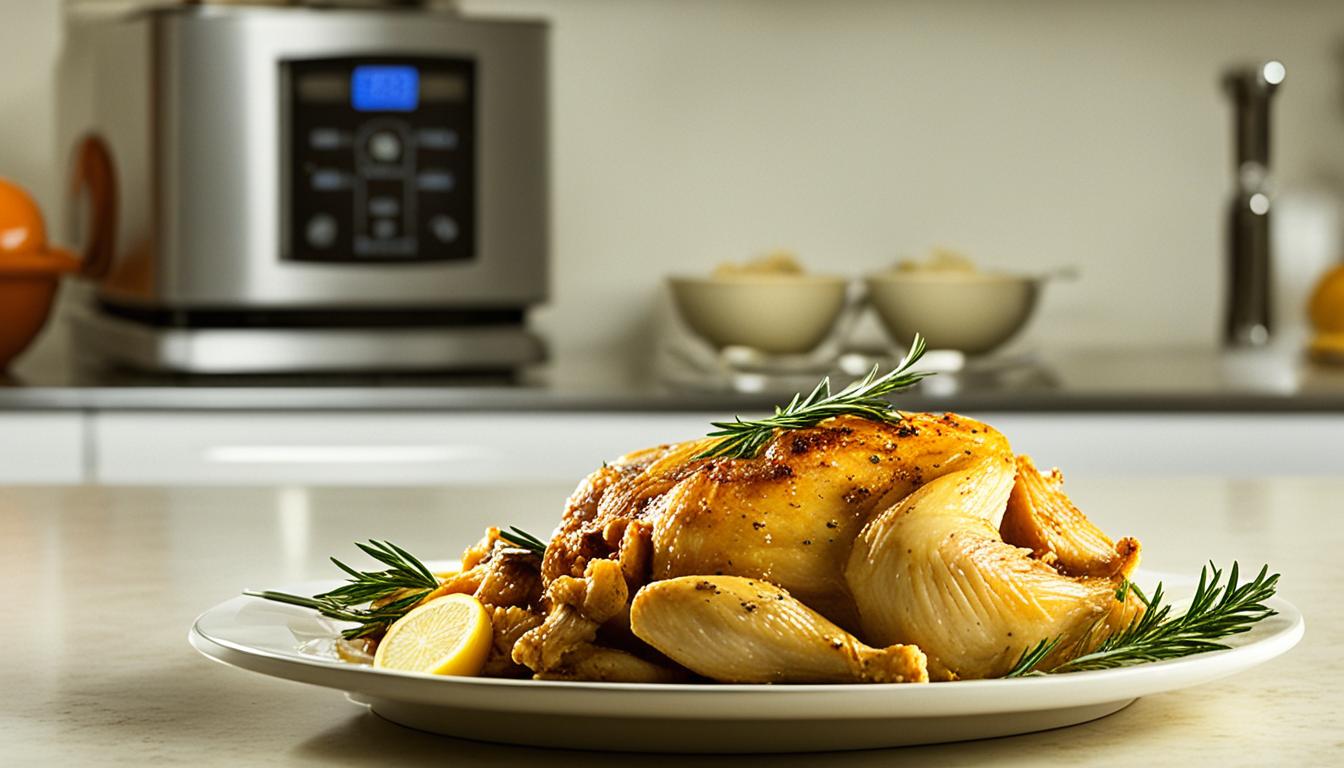Knowing how long cooked chicken can stay out is key for food safety. If it’s left out too long, bacteria can grow causing illness. This article discusses safe time limits and risks of eating bad chicken.
Key Takeaways:
- According to food safety guidelines, cooked chicken should not be left out at room temperature for more than two hours.
- If the room temperature is above 90°F, the time limit decreases to just one hour.
- Leaving cooked chicken out for longer periods can lead to bacterial growth and increase the risk of foodborne illness.
- Proper storage of cooked chicken in the refrigerator within two hours is essential to prevent the growth of harmful bacteria.
- Discard any cooked chicken that shows signs of spoilage, such as a strange odor, slimy texture, or unusual color.
The Danger Zone – 40°F and 140°F (4°C and 60°C)
The danger zone for food is between 40°F and 140°F (4°C to 60°C). In this range, bacteria grow fast. It’s vital to manage this zone to stop bacteria and avoid foodborne sicknesses.
Food, like chicken, is at risk in this temperature span. It’s the perfect spot for bacteria to boom. Bacteria such as Salmonella and E.coli grow fast here, causing sicknesses that can seriously affect our health.
To keep food safe, we must keep chicken below 40°F or above 140°F. This means cooling cooked chicken within two hours and keeping it at a safe temp in the fridge or freezer.
“The danger zone is critical in managing bacterial growth. By maintaining chicken’s temperature outside this zone, the risk of illness drops.”
Keeping chicken below 40°F stops bacteria from growing. This means putting chicken in the fridge right after cooking it or thawing.
It’s also crucial to cook chicken to a safe temperature of 165°F. Using a food thermometer checks that the chicken is fully cooked and safe.
On the flip side, heating chicken above 140°F kills bacteria. Safe cooking methods like grilling, baking, or frying achieve this. They make sure chicken is safe to eat.
Grasping the danger zone is key for food safety. By managing chicken temperatures well, we lessen foodborne illness risks. So, we can relish tasty, safe meals.
How Long Can Raw Chicken Sit Out?
Handling raw chicken carefully is very important. You must follow food safety rules. If raw chicken is left out too long, it can grow harmful bacteria. This makes it unsafe to eat.
Experts say raw chicken should not stay out longer than two hours. This keeps the chicken safe and stops bacteria from growing. Keeping chicken within this time limit lowers the chance of getting sick.
If the room is hotter than 90°F, the limit is only one hour. Hotter temperatures make bacteria grow faster. So, it’s very important to put raw chicken in the fridge quickly.
Following these rules can make eating chicken safer. Keeping chicken cold stops diseases. This helps keep you and your family healthy.
Below is a table that shows these time rules:
| Room Temperature | Maximum Time Limit |
|---|---|
| Below 90°F (32°C) | Up to 2 hours |
| Above 90°F (32°C) | Up to 1 hour |
This table is a quick guide to keep your chicken safe. If you’re not sure if chicken is safe, throw it away. It’s better to be safe than sorry.
How Long Can Cooked Chicken Sit Out?
Cooked chicken should not sit at room temperature longer than two hours. If it’s over 90°F, like at a picnic, only leave it out for one hour. It’s crucial to put it in the fridge within two hours to stop bacteria and keep it safe.
“Proper handling and storage of cooked chicken is essential to prevent bacterial growth and reduce the risk of foodborne illnesses.”
It’s not safe to leave cooked chicken out too long. Bacteria grow fast between 40°F and 140°F. This includes most indoor temperatures.
If chicken sits out, it gets warm. Warmth makes bacteria grow faster. That increases the chance of getting sick. So, keep cooked chicken out for no more than two hours.
When it gets hotter than 90°F, bacteria grow even faster. That’s why, at picnics or barbeques, chicken should only stay out for an hour. Watch the time closely, so your chicken can be refrigerated quickly.
Putting cooked chicken in the fridge quickly is key. It stops bacteria from growing. Use shallow, airtight containers or wrap it well before chilling. This keeps it safe and tasty.
Eating chicken that’s been out too long can make you sick. Always refrigerate it within two hours. This keeps your food safe and enjoyable.
Guidelines – How Long Can Cooked Chicken Sit Out?
| Temperature | Maximum Time |
|---|---|
| Below 90°F | Two hours |
| Above 90°F | One hour |
These rules help stop bacteria from growing. By caring about food safety, you ensure your cooked chicken stays safe and delicious.
Signs of Spoiled Chicken
When it comes to chicken, it’s essential to make sure it’s fresh and safe to eat. Look out for several signs of spoiled chicken. This way, you and your loved ones stay safe from foodborne illnesses. Recognizing these signs early helps you avoid the dangers of bad chicken.
Appearance
One of the first signs of bad chicken is its appearance. Check for any color changes or odd discoloration. Fresh chicken is usually pinkish, while spoiled one might look gray or green. If you see mold or weird spots, throw it away immediately.
Smell
The smell of chicken can tell you a lot about its quality. Fresh chicken smells mild and neutral. But, if it smells bad or off, it’s probably not good. Always trust your nose and when in doubt, it’s better to be safe and not eat it.
Texture
The texture of the chicken is also key. Bad chicken might feel slimy or sticky. You want your chicken to be firm and smooth. If it’s slimy or feels weird, it’s safest to throw it out to avoid health issues.
Expiration Date
Don’t forget to check the expiration date on your chicken’s package. While it’s not a perfect rule, it gives you an idea of how fresh your chicken is. If it’s past this date, especially with other spoilage signs, it’s better to toss it.
| Signs of Spoiled Chicken |
|---|
| Gray or greenish color |
| Mold or strange discoloration |
| Unpleasant smell |
| Slimy texture |
| Expired expiration date |
These signs are a great guide to check your chicken’s freshness and safety. If you notice any, it’s wiser to throw out the chicken to avoid getting sick. By being careful and handling your food correctly, you can make sure your chicken is both safe and tasty.
Proper Storage of Cooked Chicken
Storing cooked chicken the right way is key to keeping it safe and tasty. Here’s what you need to do:
Refrigeration within Two Hours
Put the chicken in the fridge within two hours after cooking. This stops bacteria from growing. The cold temperature keeps the chicken safe for later.
To refrigerate cooked chicken:
- Use an airtight container or seal it with strong, safe plastic wrap. This keeps it moist and blocks germs.
- Write down the storage date on the container. This helps you remember when it’s still good to eat.
- Put the chicken on a shelf by itself. Keep it away from raw meat to prevent germs from spreading.
Separate Raw and Cooked Chicken
Always keep raw and cooked chicken apart in the fridge. Raw chicken has bacteria that could make cooked chicken unsafe.
To keep them separate:
- Store raw chicken in a container that won’t leak. This keeps its juices from touching cooked chicken.
- Place raw chicken on its own shelf. It should be far from other foods.
- Use different tools for raw and cooked chicken. This stops bacteria from moving around.
Freezing for Long-Term Storage
If you’re not eating your cooked chicken soon, freeze it. Freezing keeps it safe and retains its quality.
- Wrap the chicken well for the freezer. This protects its flavor and stops freezer burn.
- Label the chicken with the freezing date. This lets you track how long it’s been stored.
- Keep it at 0°F (-18°C) or colder. This is the right temperature for freezing.
Cooked chicken stays good for three to four days in the fridge. In the freezer, it lasts up to six months. Always thaw it in the fridge or use cold water. Make sure it’s heated to 165°F (74°C) before eating again.
Correct storage and care of cooked chicken stop foodborne illnesses. With these tips, you can enjoy safe, delicious chicken meals every time.
Freezing and Thawing Cooked Chicken
Freezing is a great way to extend cooked chicken’s shelf life. It keeps the quality high and stops bacteria from growing. This keeps food safe for a long time.
To freeze cooked chicken right, use the correct storage containers. This stops freezer burn and keeps the flavor. Put the chicken in an airtight container or freezer bag. Push out all the air to stop ice from forming.
Write the date on the container to remember how fresh it is. When stored at 0°F (-18°C), cooked chicken is safe for four months. But, it’s best to eat it within two to three months for the best flavor.
To enjoy your frozen cooked chicken, thaw it right. Thawing in the fridge overnight is the best. It slowly brings the chicken to a safe temperature. This keeps both the safety and taste.
Tip: In a rush? You can thaw chicken faster in two ways. Use a cold-water bath with the chicken in a sealed bag. Change the water every 30 minutes. Or, use the microwave’s defrost setting. But, microwaves can thaw unevenly, leaving some parts partially cooked.
Make sure the chicken is safe to eat after thawing, no matter the method. Check its internal temperature with a food thermometer. It should be at least 165°F (74°C) to kill bacteria.
Proper Thawing Methods for Cooked Chicken:
- Refrigerator thawing: Recommended for the best taste and safety. Plan ahead and thaw the cooked chicken in the refrigerator overnight.
- Cold-water bath: Ideal when you need to thaw the chicken more quickly. Seal the chicken in a leak-proof bag and submerge it in cold water, replacing the water every 30 minutes.
- Microwave defrosting: Use the microwave’s defrost setting, but be cautious as it may result in uneven thawing.
Thawed cooked chicken should be eaten within two to three days. You can refreeze leftovers, but they might lose some quality. Always handle food safely and follow these guidelines for tasty and safe chicken.
| Thawing Method | Pros | Cons |
|---|---|---|
| Refrigerator Thawing | – Best for taste and safety – Controlled thawing process – Minimal moisture loss |
– Requires advance planning – Takes longer |
| Cold-water Bath | – Relatively quick thawing – Does not compromise texture as much as other methods |
– Requires more active monitoring – Water needs to be changed regularly |
| Microwave Defrosting | – Fastest thawing method – Convenient for last-minute meals |
– May result in uneven thawing – Can partially cook areas of the chicken |
Risks of Eating Spoiled Chicken
Eating spoiled chicken is risky for your health. Spoiled chicken can contain bad bacteria, leading to food poisoning. These bacteria can make you feel very sick.
Food poisoning symptoms may include:
- Nausea
- Vomiting
- Diarrhea
- Stomach cramps
- Fever
- Dehydration
Food poisoning severity varies with the bacteria and your immune system. It can upset daily life and sometimes needs a doctor.
Spoiled chicken might have Salmonella, Campylobacter, and Staphylococcus aureus. Improper storage or old chicken can increase these bacteria.
You should throw away any chicken that looks or smells bad. Eating it can cause serious health problems and long illnesses. Knowing how to handle food and spotting spoiled chicken prevents foodborne sickness.
Proper food handling is the key to preventing foodborne illnesses.
Follow food safety rules and store chicken right to avoid bacteria. Always throw away spoiled or old chicken. Keep your health first by handling food safely.
Importance of Proper Food Handling
Ensuring food safety and preventing foodborne illnesses are key with chicken. By following food safety guidelines, we can stop bacterial growth. This keeps our meals safe and tasty. Here are some important tips:
1. Storage Guidelines
Proper storage is key for raw and cooked chicken’s quality and safety. Keep raw chicken in the fridge below 40°F (4°C). This stops harmful bacteria from growing. Cooked chicken should go in the fridge within two hours after cooking.
“Storing chicken at the right temperature is vital in controlling the risk of foodborne illnesses.” – Food Safety Expert
To store chicken properly:
- Put raw chicken in leak-proof containers or bags. This avoids cross-contamination.
- Store cooked chicken in airtight containers or wrap it well. This keeps it fresh.
- Always keep raw and cooked chicken separate in the fridge.
| Storage Method | Refrigerator | Freezer |
|---|---|---|
| Raw Chicken | Up to 2 days | 9-12 months |
| Cooked Chicken | 3-4 days | 4-6 months |
2. Prevention of Cross-Contamination
To stop harmful bacteria from spreading:
- Use different cutting boards and utensils for raw and cooked chicken.
- Wash your hands, surfaces, and tools with hot, soapy water after touching raw chicken.
- Avoid reusing marinades or sauces that touched raw chicken.
3. Proper Cooling and Refrigeration of Leftovers
It’s important to cool and refrigerate leftovers quickly. Bacteria grow fast if food is left out. Keep these tips in mind:
- Put leftovers in shallow, airtight containers for fast cooling.
- Refrigerate leftovers within two hours.
- Heat leftovers to 165°F (74°C) before eating.
Proper food handling keeps us safe from foodborne illnesses. By storing chicken right, stopping cross-contamination, and cooling leftovers quickly, we stay healthy. Let’s focus on food safety and enjoy our meals worry-free.
Conclusion
To keep your cooked chicken safe, always follow food safety rules and store it right. Make sure to refrigerate it within two hours. This stops bacteria that can make you sick from growing.
Don’t leave cooked chicken out too long. Room temperature can make bacteria grow faster.
Throw away any chicken that looks, smells, or feels off. Check its color, smell, and texture. Also, don’t use it if the expiration date has passed. Keeping your chicken safe cuts down on food-related illnesses.
Safe food practices keep you and your loved ones healthy. Handling your food correctly prevents bacterial growth and keeps your meals safe.





